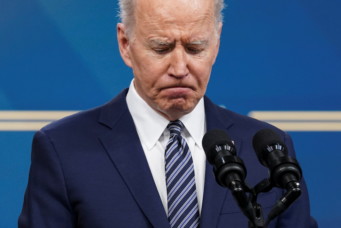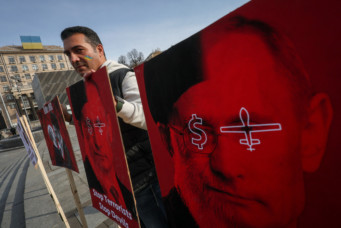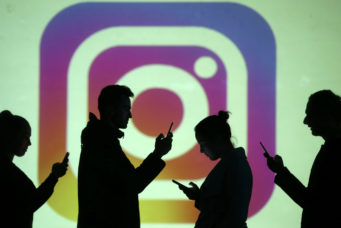Social Media as a Propaganda Tool in the Russia-Ukraine Conflict
Sixty-one percent of Arab youth use social media as a news source. But what happens when some of these platforms are used to spread misinformation and propaganda, especially in times of war?

People holding mobile phones are silhouetted against a backdrop projected with the Twitter logo. Sept. 27, 2013. Kacper Pempel/Reuters
Social media has generated a wealth of propaganda and disinformation surrounding the Russia-Ukraine War and has become a veritable information battleground as both countries use social media to discredit each other and influence global opinion. More people, especially youth, are using social media to access what they perceive to be more reliable news. Social media is also easier and faster to access and most importantly, users place a high value on its interactivity.
In the Arab World, social media is the number one source of news for young people. According to the Arab Youth Survey, 61 percent of Arab youth use social media for news while 34 percent consume news online and 9 percent via newspapers. In an interview with Arab News, Fares Akkad, Meta’s director of media partnerships for news in growth markets across Asia Pacific, Latin America, Middle East Africa, and Turkey, noted that MENA region youth increasingly depend on social media platforms for access to information, especially visual content. This has put them in the line of fire when it came to receiving propaganda and disinformation about the Ukraine War.
While social media has become a means of shaping public perceptions of the war, in reality, it is not the most reliable source for news, especially during times of war when it can become an effective vehicle for disseminating false information.
Furthermore, it is not just these online forces that influence the public.
In this digital age, most audiences and social media users are not passive consumers of media but are proactively seeking out media that meets their political views and beliefs. In the meantime, trust in mainstream media has declined in most Arab countries for numerous reasons, largely due to the prevalence of fake news and doubts about the integrity of sources. As a result, users themselves become unwitting participants when they share inaccurate content.
Social Media as Propaganda
As the Russia-Ukraine unfolded, it became clear that both are using social media to manipulate the truth, and many examples abound.
On February 25, 2022, the day after Russia first launched its attack on Ukrainian territory, social media affiliated with the Russian government spread the rumor that Ukrainian President Volodymyr Zelenskyy had fled abroad. After the news spread, President Zelenskyy uploaded a short video to social media showing himself in the Ukrainian capital Kyiv. This propagated disinformation is a key modern-day tool of warfare propaganda. Another example of a propaganda tool is the use of historical facts (in this case, wars of aggression) to correlate to modern-day events. On its Twitter account, the Ukrainian government shared a cartoon of Adolf Hitler looking down with pride at President Vladimir Putin, with his hand placed on Putin’s face. The cartoon directly ties Putin to one of the most hated warmongers in history and points to the horrors of sharing a border with an aggressive Russian government.
Disinformation is not limited to the depictions of the Russian and Ukrainian presidents, however. Fake news about the war on the ground plays a role in influencing the outcome of the conflict and can easily mislead the public who are desperate to know what is happening. For example, in February 2022, an account calling itself “CNN Ukraine” claimed an activist named Bernie Gores was the “first American casualty of the Ukraine crisis,” having been killed by a “mine planted by Russian backed separatists”. Tweets about this supposed event were circulated by hundreds of thousands of people on social media. However, back in August 2021, a tweet from an account calling itself “CNN Afghanistan,” claimed a journalist named Bernie Gores had been executed by the Taliban in Kabul. The two tweets used the same photo of Bernie Gores. Numerous social media users were duped by the fake accounts and criticized CNN for supposedly reporting that the same man died in two different wars.
Another propaganda technique uses emotive footage to foster suspicion. For example, a video was viewed more than 1.3 million times in various Facebook posts claiming it depicted Russian and Ukrainian soldiers fighting on February 26, 2022. The video states: “The battle between Ukraine and Russia is heating up.” The claim turned out to be false. The video has been circulating since at least 2019 in posts about French Foreign Legion troops in battle in Mali.
However, public opinion is also shaped by individual political affiliation, background and interests. As a result, different points of view on the Russia-Ukraine conflict are seen in the Arab world.
Arab Public Opinion Vis-à-vis the Ukraine War
In the above section, we saw how social media is manipulated for propaganda purposes and how easily it can spread certain kinds of disinformation. However, it can also shape public views about leadership, which in turn influences opinion. For example, Putin may be described as a dashing and charismatic figure while Zelenskyy is contrasted as a comedian. Traditional media also buy into this type of propaganda. In March 2022, a narrative was posted on social media claiming Putin was pro-Islam and Zelenskyy had a Jewish and anti-Islam background. Claims such as these are likely to influence public opinion.
Social media users, including those in the Arab World, are not merely unwitting victims of misleading information. A large number believe false narratives because of their political realities and in order to meet their own political views. This is known as Uses and Gratifications Theory (UGT) by media theorists, and it is an approach to understand why and how people actively seek out specific media to satisfy specific needs. UGT assumes that audience members are not passive consumers of media, but rather have agency and assume an active role in interpreting and integrating media into their lives. UGT holds that audiences are responsible for choosing media to meet their inclinations and to feel gratified.
With this theory in mind, the Russia-Ukraine War has provoked a debate among Arabs. According to Egyptian writer and researcher Amr Salah at the Carnegie Endowment for International Peace, although many Arabs intuitively empathize with the Ukrainian people, social media reveals significant support for Putin in spite of the evidence of the horrors of the conflict and its global economic impact. Given this, it is curious that support for Putin persists in the Arab World.
In fact, since 2011 and the bitter experience of the so-called Arab Spring, polarization in the Middle East has shaped the Arab public’s reactions to politics, including the Russian invasion of Ukraine. Salah argues part of this polarization comes from the ongoing struggle between two narratives aiming to explain the causes of Arab revolutions and the demise of many Arab countries since 2011. One narrative argues decline is the inevitable outcome of widespread, decades-long corruption throughout the region. The counter-narrative places the blame on Arab revolutionists, political Islamist opportunists, and the West; those who buy into the counter-narrative are largely supporters of Putin.
Salah finds that supporters of this counter-narrative mostly view the Ukrainian president as a Western puppet who initiated hostilities and threatened Russia. On the other hand, they see the Russian president as the creator of a new nation, a leader challenging Western hegemony, and a commander who runs a powerful home-grown military able to lend support to Arab and Muslim countries. A unified Western conspiracy behind the two events is often alleged.
Accordingly, people consume certain television channels or social media platforms because these outlets frame information or directly convey messages which support their preexisting beliefs and views. Over recent decades, people in Arab countries have sought out pro-Putin Russian analysts due to Russian support for Arab causes in international forums.
However, even with this degree of support for the Russian president in the media, according to the Arab News-YouGov survey, the majority of the Arab public has no particular stance on the Russia-Ukraine conflict. Out of 7,835 respondents from the Arab World, 66 percent did not have an opinion on the Russia-Ukraine conflict, while 18 percent favored Ukraine, and 16 percent favored Russia. The majority of respondents who sided with Russia came from 4 out of 14 countries surveyed: Algeria (19 percent), Oman (19 percent), Qatar (19 percent), and Tunisia (18 percent). The survey analysis notes it is surprising that Egyptians—who source 85 percent of their wheat from Russia and Ukraine—do not feel more strongly about the conflict.
Most Arabs may have no stance on the Russia-Ukraine conflict due to the fact that the war is geographically distant. Additionally, Arab public opinion might also reflect the perspectives of their respective governments, which view the conflict as European. This type of audience, one which holds no strong opinions, might be more easily influenced by propaganda and disinformation in the media and needs to be trained in dissecting information.
There is no substitute for robust journalism that is accurate, fair, objective, and keeps bias and propaganda out of reporting. If these principles are violated, people will continue to migrate to social media, where they find more independence and perceived objectivity. This only further complicates matters, specifically during times of war, as social media is again and again shown to be an effective vehicle for spreading misinformation. The amplified usage of propaganda deepens public distrust of the media, especially among engaged audiences, and will not produce solutions to foreign policy problems or lead to lasting solutions to the Russian-Ukrainian conflict.
Najat Al-Saied is an adjunct professor at the American University in the Emirates, specializing in political media and communication. Her book, Twitter Diplomacy: Media Polarization Before and After the Abraham Accords has been classified as a best seller in the United States.
Read More



